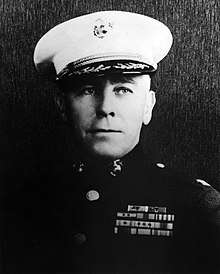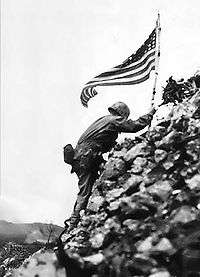Richard P. Ross Jr.
| Richard Potts Ross Jr. | |
|---|---|
 Ross Jr. as colonel, USMC | |
| Born |
March 18, 1906 Frederick, Maryland |
| Died |
October 6, 1990 (aged 84) Laguna Hills, California |
| Buried | Arlington National Cemetery |
| Allegiance |
|
| Service/ |
|
| Years of service | 1927-1957 |
| Rank |
|
| Service number | 0-4276 |
| Commands held |
CoS, MCRD San Diego 7th Marine Regiment 1st Marine Regiment 3rd Battalion, 1st Marines 16th Defense Battalion |
| Battles/wars |
Nicaraguan Campaign Korean War |
| Awards |
Legion of Merit (2) Bronze Star Medal (2) |
Richard Potts Ross Jr. (March 18, 1906 - October 6, 1990) was a highly decorated officer of the United States Marine Corps with the rank of Brigadier General. He is most noted for his service with the 1st Marine Division during the Battle of Okinawa and later during the Occupation of North China.[1][2]
Early years
Richard P. Ross was born on March 18, 1906 in Frederick, Maryland as the son of Richard P. Ross Sr. and attended the Staunton Military Academy in Staunton, Virginia. Following the graduation in summer of 1923, he received appoitment to the United States Naval Academy in Annapolis, Maryland and graduated on June 2, 1927. He was commissioned Second lieutenant in the Marine Corps on the same date.[3][1][2]
Many of his classmates became general officers later: George W. Anderson, Jr., Glynn R. Donaho, John C. Munn, Alan Shapley, Clarence E. Coffin, Samuel H. Crittenden Jr., Timothy F. Donohue, Thomas J. Hamilton, Herbert L. Hoerner, William P. Chilton, Alexander M. Kowalzyk, William L. Knickerbocker, Leland R. Lampman, William H. Leahy, William F. Royall, Brooke Schumm, Francis M. McAlister, Samuel S. Jack, Jack P. Juhan, David F. O'Neil, Henry R. Paige, Walter L. J. Bayler, Joseph W. Earnshaw, Harold D. Hansen, Archie E. O'Neil, Miles S. Newton or Earl S. Piper.[4][1]
Ross was subsequently ordered to the Basic School at Philadelphia Navy Yard for further officers' education and completed the school in next summer. Ross then served at Marine Barracks within Naval Station Norfolk, Virginia until 1928, when he left with 2nd Brigade of Marines for expeditionary duty to Nicaragua.[3][1]
He participated in the jungle patrols against rebels under Augusto César Sandino for several months, before he was ordered to the United States in May 1929. Ross went overseas again in October of that year and served with Marine Detachment, American Legation in Peiping, China until 1932. Following his return stateside, Ross completed the Company Officers' Course at Marine Corps Schools, Quantico and subsequently served with the Marine Barracks, Washington, D.C. and later with Marine Barracks at Mare Island Naval Shipyard, California.[1]
Upon the promotion to the rank of Captain, Ross was appointed Commanding officer of the Marine Detachment aboard the battleship USS Colorado in August 1935 and spent almost two years with sea duties in Pacific Ocean. He was appointed an instructor in naval ordnance and gunnery at the Naval Academy in June 1937 and remained in that capacity for the next two years. Ross then served as a Company Commander with 6th Marines in San Diego until the summer of 1941, when he assumed duties as Commander of the Marine Detachment aboard the battleship USS Oklahoma.[1][2]
World War II

Ross was aboard the Oklahoma during the Japanese attack on Pearl Harbor on December 7, 1941 and took part in the defense of the ship. Following the sinking of the Oklahoma by Japanese planes, he and his detachment were temporarily attached to the Marine Barracks within Pearl Harbor Navy Yard until he was ordered for the instruction with a machine gun group of the 3rd Defense Battalion under the command of lieutenant colonel Robert H. Pepper. Ross was promoted to the rank of Major in January 1942 and then ordered to the newly activated 10th Defense Battalion under Lieutenant colonel Robert Blake in June 1942 at San Diego. He was promoted to the rank of lieutenant colonel in September 1942 and served as Commanding officer of Special Weapons Group until November of that year, when he was ordered to Johnston Atoll as Commanding officer of newly activated 16th Defense Battalion.[1]
His unit consisted of the batteries with 5"/51 caliber guns, searchlight and aircraft sound locator and antiaircraft groups with M2 Browning and M1917 Browning machine guns and were ideal for the defense of the islands from the attack from the sea and air.[5]
Ross was ordered to the States in July 1943 and attached to the Headquarters Marine Corps in Washington, D.C. as Operations and Training officer, Division of Plans and Policies under Brigadier general DeWitt Peck. He spent almost one year in this capacity, before he was ordered back to the Pacific theater in June 1944 and attached to the 1st Marine Division under Major general William H. Rupertus at Russell Islands.[3][1]
He succeeded lieutenant colonel Walker A. Reaves as an Executive officer of the 1st Marine Regiment under famous Colonel Chesty Puller and supervised the training and preparation of the regiment for upcoming campaign in the Palaus. Ross took part in the bloody battle of Peleliu during the fall of 1944 and received Bronze Star Medal with Combat "V" and Navy Presidential Unit Citation for his service there. The First Marines suffered heavy casualties during the Peleliu campaign and Ross spent following months with the training of replacements on Pavuvu, Russell Islands. He also held temporary command of 1st Marine Regiment following the departure of Colonel Chesty Puller back to the States from November 4th to December 12th 1944.[6][7]
In April 1945, Ross took part in the battle of Okinawa and because of the course of the battle, he held temporary command of 1st Battalion, 1st Marines for two days after its commander has been wounded in action and subsequently assumed command of 3rd Battalion, 1st Marines on May 21, 1945. He led his 3rd Battalion during the fierce fighting and his marines took part in several hand-to-hand combats and bayonet charges. Ross and his battalion also fight with lack of food and supplies, but 96th Infantry Division provided rations to his marines.[8]
Ross remained with his unit in the combat area until the end of June 1945 and received Legion of Merit with Combat "V" for his brilliant leadership during the battle. He also received his second Navy Presidential Unit Citation.[9][3][10][2]
Later career

Following the Okinawa campaign, the units of 1st Marine Division were preparing for the Invasion of Japan, but formal surrender on September 2, 1945 changed the plans. Ross was promoted to the rank of Colonel at the same time and appointed Commanding officer of 7th Marine Regiment, 1st Marine Division under his old superior, major general DeWitt Peck. The Seventh Marine Regiment was ordered to Hopeh Province, China in order to accept surrender of Japanese garrisons in Tientsin and its subsequent repatriation to Japan.[1][11]
During October 1945, Ross and his regiment were ordered for guard duty of rail line between Tanggu and Chinwangtao and also for protection of coal mines in Tangshan. Their goal was to make sure, that coal destined for Shanghai moved uninterrupted along the line, but activity of communists guerrilla units increased and marines outposts came under fire at several occasions. Ross participated in the operations against communists guerillas until the end of January 1946, when he was ordered back to the United States. He was decorated with Legion of Merit by the U.S. Army and his second Bronze Star Medal by the Marines. Ross also received Order of the Cloud and Banner, 5th Class by the Government of Republic of China.[3][2]
Upon his return stateside, Ross attended Command and General Staff Course at Marine Corps Schools, Quantico and following the graduation, he was ordered to Washington, D.C. for duty with Joint War Plans Committee, Navy Department. He remained in this capacity until summer 1947, when he was ordered for instruction at National War College. Ross graduated one year later and assumed duties ad Officer in Charge of Strategic Plans Section, Headquarters Marine Corps.[3][1]
In June 1950, Ross was ordered to the Far Eastern Area and appointed Commanding officer of Marine Barracks at Naval Base Yokosuka. He served in this capacity during Korean War and was ordered back to the United States in October 1952. He then served as Chief of Staff, Marine Corps Recruit Depot San Diego under Major general John T. Walker until 1954, when he was appointed Area Staff Representative, Operations Coordinating Board. Ross was appointed to his final assignment in 1955 when he was assigned to the Staff of the Net Evaluation Subcommittee, National Security Council.[3][2]
Richard P. Ross Jr. retired from active service on June 28, 1957 after 30 years of active service and was advanced to the rank of Brigadier General on the retired list for having been specially commended in combat. He then settled in Laguna Hills, California with his wife, Catherine P. Ross (1909-1993) and died there on October 6, 1990. He was buried at Arlington National Cemetery, Virginia with full military honors.[12][2]
Decorations
Here is the ribbon bar of Brigadier General Richard P. Ross Jr.:[9][1]
References
- 1 2 3 4 5 6 7 8 9 10 11 "Richard P. Ross Jr. Papers – USMC Military History Division". USMC Military History Division. Retrieved June 7, 2018.
- 1 2 3 4 5 6 7 "Fortitudine 20, Part 3" (PDF). marines.mil. Marines Websites. Retrieved June 7, 2018.
- 1 2 3 4 5 6 7 "Library - University of Wisconsin" (PDF). images.library.wisc.edu. Image Library - University of Wisconsin. Retrieved June 7, 2018.
- ↑ "Lucky Bag - USNA Class of 1927". United States Naval Academy. Retrieved 2018-06-07.
- ↑ "Condition Red: Marine Defense Battalions in World War II – USMC Military History Division" (PDF). USMC Military History Division. Retrieved 2017-12-18.
- ↑ "US Marine Corps in World War II – HyperWar (Peleliu)". ibiblio.org. HyperWar Websites. Retrieved 26 December 2017.
- ↑ "A Brief history of the 1st Marines - USMC Military History Division" (PDF). USMC Military History Division. Retrieved June 7, 2018.
- ↑ "The Final Campaign: Marines in the Victory on Okinawa" (PDF). USMC Military History Division. Retrieved June 7, 2018.
- 1 2 "Valor awards for Richard P. Ross Jr". valor.militarytimes.com. Militarytimes Websites. Retrieved June 7, 2017.
- ↑ "US Marine Corps in World War II – HyperWar (Okinawa)". ibiblio.org. HyperWar Websites. Retrieved 26 December 2017.
- ↑ "A Brief history of the 7th Marines - USMC Military History Division" (PDF). USMC Military History Division. Retrieved June 7, 2018.
- ↑ "Richard P. Ross Jr. (1906 - 1990) – Find a Grave Memorial". Findagrave.com. 2017-12-26. Retrieved 2017-12-26.
